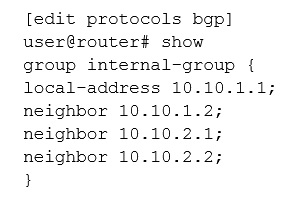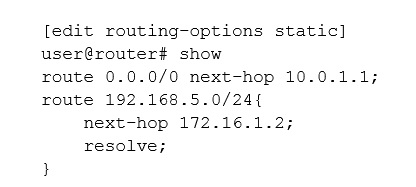Click the Exhibit.

You have configured the IBGP group shown in the exhibit. However, committing your configuration fails.
Which parameter should you add to the IBGP group configuration to correct the problem?
Click the Exhibit.

You have configured the IBGP group shown in the exhibit. However, committing your configuration fails.
Which parameter should you add to the IBGP group configuration to correct the problem?
In the given configuration for an IBGP group, the commit fails because the type of the group has not been specified. In BGP, a group must be categorized either as 'internal' or 'external' to define the relationship with peers. Since this is an IBGP group, the correct parameter to add is 'type internal'. This informs the router that the neighbors within this group are part of the same Autonomous System (AS). Specifying 'type internal' will resolve the configuration issue by allowing the router to use its own AS number for all the peers in the group.
Click the Exhibit.

Referring to the configuration in the exhibit, which statement is true?
The next-hop 172.16.1.2 must be part of an active route in route table inet.0 for route 192.168.5.0/24 to be active. This is because the resolve statement instructs the router to look up the next-hop address in the routing table (inet.0) to find a corresponding active route. If the next-hop 172.16.1.2 has an active route in inet.0, the router will use that route to forward packets to the 192.168.5.0/24 destination.
Which two statements are correct about default BGP route propagation? (Choose two.)
IBGP speakers advertise EBGP-learned routes to other IBGP peers and EBGP speakers advertise IBGP-learned routes to other EBGP peers. This is because, by default, IBGP does not propagate routes within its own peers unless a policy is specifically configured to do so. Therefore, option A is incorrect because IBGP speakers do not advertise IBGP-learned routes to other IBGP peers. Option B suggests using a policy to advertise IBGP-learned routes to EBGP peers, but by default, EBGP speakers can advertise routes learned from IBGP peers to other EBGP peers without an explicit policy, making option D correct.
You asked to deploy a large-scale IS-IS network with multiple areas.
In this scenario, which two statements are true? (Choose two.)
For an IS-IS network, the area IDs must be the same for Level 1 routers to form an adjacency. This means Level 1 routers within the same area can form adjacencies, ensuring intra-area routing. For Level 2 routers, they maintain inter-area routing and can form adjacencies with other Level 2 routers regardless of area IDs. Therefore, the area IDs must be the same for Level 1 routers to form an adjacency, and Level 2 routers can form adjacencies even if their area IDs differ.
You want to save adjacency formation time between two routers participating in OSPF, as well as reduce the size of the OSPF link-state database.
How would you accomplish these tasks?
Defining a point-to-point connection in OSPF can minimize adjacency formation time and trim down the OSPF link-state database. This is because point-to-point links do not require a DR/BDR election process, speeding up adjacency formation. Moreover, these links do not produce Type 2 LSAs for multi-access segments, thereby reducing the size of the database.